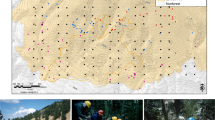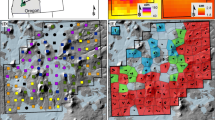Abstract
Fire regimes often vary at fine spatial scales in response to factors such as topography or fuels while climate usually synchronizes fires across broader scales. We investigated the relative influence of top-down and bottom-up controls on fire occurrence in ponderosa pine (Pinus ponderosa) forests in a highly fragmented landscape at Mount Dellenbaugh, in northwestern Arizona. Our study area of 4,000 ha was characterized by patches of ponderosa pine forest in drainages that were separated by a matrix of pinyon–juniper woodlands, sagebrush shrublands, and perennial grasslands. We reconstructed fire histories from 135 fire-scarred trees in sixteen 25-ha sample sites placed in patches of mature ponderosa forest. We found that, among patches of ponderosa forest, fires were similar in terms of frequency but highly asynchronous in terms of individual years. Climate synchronized fire but only across broader spatial scales. Fires occurring at broader scales were associated with dry years that were preceded by several wet years. The remarkable level of asynchrony at finer scales suggests that bottom-up factors, such as site productivity and fuel continuity, were important in regulating fire at Mount Dellenbaugh. Understanding where bottom-up controls were historically influential is important for prioritizing areas that may best respond to fuel treatment under a warming climate.






Similar content being viewed by others
References
Adams DK, Comrie AC (1997) The North American monsoon. Bull Am Meterol Soc 78:2197–2213
Alcoze T (2003) First Peoples in the pines: historical ecology of humans and ponderosa. In: Friederici P (ed) Ecological restoration of southwestern ponderosa pine forests. Island Press, Washington, pp 48–57
Allen CD (2002) Lots of lightning and plenty of people: an ecological history of fire in the upland Southwest. In: Vale TR (ed) Fire, native peoples, and the natural landscape. Island Press, Washington, DC, pp 143–193
Altschul JH, Fairley HC (1989) Man, models, and management: an overview of the archaeology of the Arizona Strip and the management of its cultural resources. Report prepared for U.S. Forest Service and U.S. Department of the Interior, Bureau of Land Management, by Statistical Research, Plateau Arcaeology, Dames and Moore, Tucson, Contract No. 53-8371-6-0054
Belshaw M, Peplow E, Jr. (1978) Historic resources study, Lake Mead National Recreation Area, Arizona. National Park Service, Western Archaeological and Conservation Center, Tuscon
Belsky AJ, Blumenthal DM (1997) Effects of livestock grazing on stand dynamics and soils in upland forests of the interior west. Conserv Biol 10(5):315–327
Biondi F, Jamieson LP, Strachan S, Sibold J (2011) Dendroecological testing of the pyroclimatic hypothesis in the central Great Basin, Nevada, USA. Ecosphere 2(1):1–20
BLM, NPS (2007) Arizona Strip, Grand Canyon-Parashant and Vermillion Cliffs Monuments Final Environmental Impact Statement. U.S. Department of the Interior, Bureau of Land Management and National Park Service, Available online at: http://www.blm.gov/az/st/en/info/nepa/environmental_library/eis/strip_FEIS_07.html
Brown PM, Heyerdahl EK, Kitchen SG, Weber MH (2008) Climate effects on historical fires (1630–1900) in Utah. Int J Wildland Fire 17:28–39
Bureau of Land Management (2004) Landscape assessment for the Buckskin Mountain area. Grand Staircase-Escalante National Monument, Kanab
Collins BM, Miller JD, Thode AE, Kelly M, van Wagtendonk JW, Stephens SL (2009) Interactions among wildland fires in a long-established Sierra Nevada natural fire area. Ecosystems 12:114–128
Cook ER, Woodhouse CA, Eakin CM, Meko DM, Stahle DW (2004) Long-term aridity changes in the western United States. Science 306:1015–1018
Covington WW, Moore MM (1994) Southwestern ponderosa forest structure: changes since Euro-American settlement. J For 92:39–47
Dale VH, Joyce LA, McNulty S, Neilson RP, Ayres RP, Flannigan MP, Hanson PJ, Irland LC, Lugo AE, Peterson CJ, Simberloff D, Swanson FJ, Stocks BJ, Wotton BM (2001) Climatic change and forest disturbances. Bioscience 51(9):723–734
Daly C, Gibson WP, Taylor GH, Johnson GL, Pasteris P (2002) A knowledge-based approach to the statistical mapping of climate. Climate Res 22:99–113
Falk DA, Miller C, McKenzie D, Black AE (2007) Cross-scale analysis of fire regimes. Ecosystems 10:809–826
Finney MA, McHugh CW, Grenfell IC (2005) Stand- and landscape-level effects of prescribed burning on two Arizona wildfires. Can J For Res 35:1714–1722
Flatley WT, Lafon CW, Grissino-Mayer HD (2010) Climatic and topographic controls on patterns of fire in the southern and central Appalachian Mountains, USA. Landscape Ecol 26:195–209
Fulé PZ, Crouse JE, Heinlein TA, Moore MM, Covington WW, Verkamp G (2003a) Mixed-severity fire regime in a high-elevation forest of Grand Canyon, Arizona, USA. Landscape Ecol 18:465–486
Fulé PZ, Heinlein TA, Covington WW, Moore MM (2003b) Assessing fire regimes on Grand Canyon landscapes with fire-scar and fire-record data. Int J Wildland Fire 12:129–145
Grissino-Mayer HD (1995) Tree-ring reconstructions of climate and fire history at El Malpais National Monument, New Mexico. Ph.D. Dissertation, University of Arizona
Grissino-Mayer HD (2001) FHX2—software for analyzing temporal and spatial patterns in fire regimes from tree rings. Tree-Ring Res 57(1):113–122
Heyerdahl EK, Brubaker LB, Agee JK (2002) Annual and decadal climate forcing of historical fire regimes in the interior Pacific Northwest, USA. Holocene 12(5):597–604
Heyerdahl EK, McKenzie D, Daniels LD, Hessl AE, Littell JS, Mantua NJ (2008) Climate drivers of regionally synchronous fires in the inland Northwest (1651–1900). Int J Wildland Fire 17:40–49
Holmes RL (1983) Computer-assisted quality control in tree-ring dating and measurements. Tree-Ring Bull 43:69–78
Huffman DW, Fulé PZ, Pearson KM, Crouse JE (2008) Fire history of pinyon-juniper woodlands at upper ecotones with ponderosa forests in Arizona and New Mexico. Can J For Res 38:2097–2108
Iniguez JM, Swetnam TW, Yool SR (2008) Topography affected landscape fire history patterns in southern Arizona, USA. For Ecol Manag 256(3):295–303
Keane RE, Morgan P, White JD (1999) Temporal patterns of ecosystem processes on simulated landscapes in Glacier National Park, Montana, USA. Landscape Ecol 14:311–329
Kellogg L-K, McKenzie D, Peterson D, Hessl A (2008) Spatial models for inferring topographic controls on historical low-severity fire in the eastern Cascade Range of Washington, USA. Landscape Ecol 23(2):227–240
Kennedy MC, McKenzie D (2010) Using a stochastic model and cross-scale analysis to evaluate controls on historical low-severity fire regimes. Landscape Ecol 25:1561–1573
Kitzberger T, Brown PM, Heyerdahl EK, Swetnam TW, Veblen TT (2007) Contingent Pacific-Atlantic Ocean influence on multicentury wildfire synchrony over western North America. Proc Natl Acad Sci USA 104(2):543–548
Littell JS, McKenzie D, Peterson DL, Westerling AL (2009) Climate and wildfire area burned in western U.S. ecoprovinces, 1916–2003. Ecol Appl 19(4):1003–1021
McCune B, Grace JB (2002) Analysis of ecological communities. MjM Software Design, Glenedon Beach
McKenzie D, Hessl A, Kellogg L-K (2006) Using neutral models to identify constraints on low-severity fire regimes. Landscape Ecol 21:139–152
Poulos HM, Gatewood RG, Camp AE (2009) Fire regimes of the piñon-juniper woodlands of Big Bend National Park and the Davis Mountains, west Texas, USA. Can J For Res 39:1236–1246
Romme WH, Allen CD, Bailey JD, Baker WL, Bestelmeyer BT, Brown PM, Eisenhart KS, Floyd ML, Huffman DW, Jacobs BF, Miller RF, Muldavin EH, Swetnam TW, Tausch RJ, Weisberg PJ (2009) Historical and modern disturbance regimes, stand structures, and landscape dynamics in piñon-juniper vegetation of the western United States. Rangeland Ecol Manag 62(3):203–222
SAS Institute (2008) The SAS System for Windows, Release 9.2. SAS Institute, Inc., Cary
Swetnam TW (1993) Fire history and climate change in giant sequoia groves. Science 262(5135):885–889
Swetnam TW, Baisan CH (1996) Historical fire regime patterns in the southwestern United States since AD 1700. In: Allen C. D. (ed), Fire effects in southwestern forests: Proceedings of the second La Mesa Fire Symposium. U. S. Department of Agriculture, Forest Service, RM-GTR-286, Fort Collins, Colorado, pp 11-32
Swetnam TW, Baisan CH (2003) Tree-ring reconstructions of fire and climate history in the Sierra Nevada and Southwestern United States. In: Veblen TT, Baker WL, Montenegro G, Swetnam TW (eds) Fire and climatic change in temperate ecosystems of the western Americas. Springer, New York, pp 158–195
Swetnam TW, Betancourt JL (1990a) El Niño-Southern Oscillation (ENSO) phenomena and forest fires in the Southwestern United States. In: Betancourt JL, MacKay AM (eds) Proceedings of the Sixth Annual Pacific Climate (PACLIM) Workshop, March 5–8, 1989. California Department of Water Resources, Interagency Ecological Studies Program Technical Report 23, pp 129–134
Swetnam TW, Betancourt JL (1990b) Fire—Southern Oscillation relations in the southwestern United States. Science 249:1017–1020
Swetnam TW, Betancourt JL (1998) Mesoscale disturbance and ecological response to decadal climatic variability in the American Southwest. J Climate 11:3128–3147
Taylor AH, Skinner CN (2003) Spatial patterns and controls on historical fire regimes and forest structure in the Klamath mountains. Ecol Appl 13:704–719
van Horne ML, Fulé PZ (2006) Comparing methods of reconstructing fire history using fire scars in a southwestern United States ponderosa forest. Can J For Res 36:855–867
Westerling AL, Hidalgo HG, Cayan DR, Swetnam TW (2006) Warming and earlier spring increase western U.S. forest wildfire activity. Science 313:940–943
Acknowledgments
The Grand Canyon-Parashant National Monument gave permission for the research. Thanks to Don Normandin, Michael Stoddard, Walker Chancellor, Matt Tuten, and other staff and students at the Ecological Restoration Institute for assistance with field work. Larissa Yocom, Emily Heyerdahl, and Bruce McCune, and Darren Ireland provided valuable statistical advice. Robert E. Keane, Margaret M. Moore and two anonymous reviewers provided helpful comments on the manuscript. This project was funded by a grant from Northern Arizona University’s School of Forestry Mission Research program (McIntire-Stennis) and a fellowship through Science Foundation Arizona.
Author information
Authors and Affiliations
Corresponding author
Rights and permissions
About this article
Cite this article
Ireland, K.B., Stan, A.B. & Fulé, P.Z. Bottom-up control of a northern Arizona ponderosa pine forest fire regime in a fragmented landscape. Landscape Ecol 27, 983–997 (2012). https://doi.org/10.1007/s10980-012-9753-0
Received:
Accepted:
Published:
Issue Date:
DOI: https://doi.org/10.1007/s10980-012-9753-0




